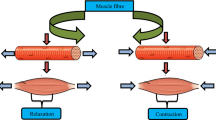Abstract
Wearable computing and sensors are becoming increasingly prevalent in our daily lives. This paper presents a wearable training system designed to facilitate the learning process of proper movement patterns in sports training. The system implements a gesture user interface and real-time biofeedback. The feedback loop consists of one or more body-attached motion sensors, a processing device and a biofeedback device that are interconnected through low-latency communication channels. Due to the diverse number of possible applications, a flexible system architecture, which includes several different system versions, is proposed. Operation of the system is driven by user gestures. To demonstrate the concept of the proposed real-time biofeedback training system, an application for golf swing training is developed. The application implements the system using smartphone motion sensors and audio biofeedback and aids golfers in correcting unwanted head movements during a golf swing. The application is driven by a gesture user interface. During the golf swing, the application provides users with real-time audio feedback that signals head movement errors. The field test results show that the developed application can be used as an efficient tool in golf swing training.












Similar content being viewed by others
References
Varkey JP, Pompili D, Walls TA (2012) Human motion recognition using a wireless sensor-based wearable system. Pers Ubiquit Comput 16:897–910
Fernando CK, Basmajian JV (1978) Biofeedback in physical medicine and rehabilitation. Biofeedback Self Regul 3:435–455
Basmajian JV (1989) Biofeedback : principles and practice for clinicians, 2nd edn. Williams & Wilkins, Baltimore
Sandweiss JH, Wolf SL (1985) Biofeedback and sports science. Springer, New York
Blumenstein B, Bar-Eli M, Tenenbaum G (2002) Brain and body in sport and exercise—biofeedback applications in performance enhancement. Wiley, New York
Giggins OM, Persson UM, Caulfield B (2013) Biofeedback in rehabilitation. J Neuroeng Rehabil 10:60
Huang H, Wolf SL, He J (2006) Recent developments in biofeedback for neuromotor rehabilitation. J Neuroeng Rehabil 3:11
Lee MY, Wong MK, Tang FT (1996) Using biofeedback for standing-steadiness, weight-bearing training. IEEE Eng Med Biol Mag 15(6):112–116
Alahakone AU, Senanayake SMNA (2010) A real-time system with assistive feedback for postural control in rehabilitation. IEEE ASME Trans Mechatron 15(2):226–233
Franco C, Fleury A, Gumery PY, Diot B, Demongeot J, Vuillerme N (2013) iBalance-ABF: a smartphone-based audio-biofeedback balance system. IEEE Trans Biomed Eng 60(1):211–215
Alahakone AU, Senanayake SMNA (2009) A real time vibrotactile biofeedback system for improving lower extremity kinematic motion during sports training. In: International conference of soft computing and pattern recognition, 2009, SOCPAR’09, 4–7 Dec 2009, pp 610–615
Kirby R (2009) Development of real-time performance measurement and feedback system for alpine skiers. Sports technology, vol 2. John Wiley and Sons Asia Pte Ltd, Singapore, pp 43–52
Crowell HP, Milner CE, Hamill J, Davis IS (2010) Reducing impact loading during running with the use of real-time visual feedback. J Orthop Sports Phys Ther 40(4):206
Lieberman J, Breazeal C (2007) TIKL: development of a wearable vibrotactile feedback suit for improved human motor learning. IEEE Trans Rob 23(5):919–926
Grewal M, Andrews A (2010) How Good Is Your Gyro [Ask the Experts]. Control Syst IEEE 30(1):12–86
Umek A, Tomažič S, Kos A (2014) Autonomous wearable personal training system with real-time biofeedback and gesture user interface. In: Proceedings of the 2014 international conference on identification, information and knowledge in the internet of things, Beijing, China, 17–18 Oct 2014
Smartphone-penetration. http://en.wikipedia.org/wiki/List_of_countries_by_smartphone_penetration
Dai J, Bai X, Yang Z, Shen Z, Xuan D (2010) Mobile phone-based pervasive fall detection. Pers Ubiquit Comput 14(7):633–643
Casamassima F, Ferrari A, Milosevic B, Ginis P, Farella E, Rocchi L (2014) A wearable system for gait training in subjects with Parkinson’s disease. Sensors 14:6229–6246
Giggins OM, Kevin TS, Caulfield B (2014) Rehabilitation exercise assessment using inertial sensors: a cross-sectional analytical study. J Neuroeng Rehabil 11:158
Pernek I, Hummel KA, Kokol P (2013) Exercise repetition detection for resistance training based on smartphones. Pers Ubiquit Comput 17(4):771–782
Wei Y, Yan H, Bie R, Wang S, Sun L (2014) Performance monitoring and evaluation in dance teaching with mobile sensing technology. Pers Ubiquit Comput 18(8):1929–1939
Stančin S, Tomažič S (2013) Early improper motion detection in golf swings using wearable motion sensors: the first approach. Sensors 13(6):7505–7521
Tiger Woods: Maintain a quiet head. http://www.golfdigest.com/golf-instruction/2009-10/tiger_woods_keep_quiet_head
Bob Doyle: Experts weigh in on head movement during the golf swing. https://foreverbettergolf.com/articles/experts-weigh-in-on-head-movement-during-the-golf-swing/
Author information
Authors and Affiliations
Corresponding author
Rights and permissions
About this article
Cite this article
Umek, A., Tomažič, S. & Kos, A. Wearable training system with real-time biofeedback and gesture user interface. Pers Ubiquit Comput 19, 989–998 (2015). https://doi.org/10.1007/s00779-015-0886-4
Received:
Accepted:
Published:
Issue Date:
DOI: https://doi.org/10.1007/s00779-015-0886-4




